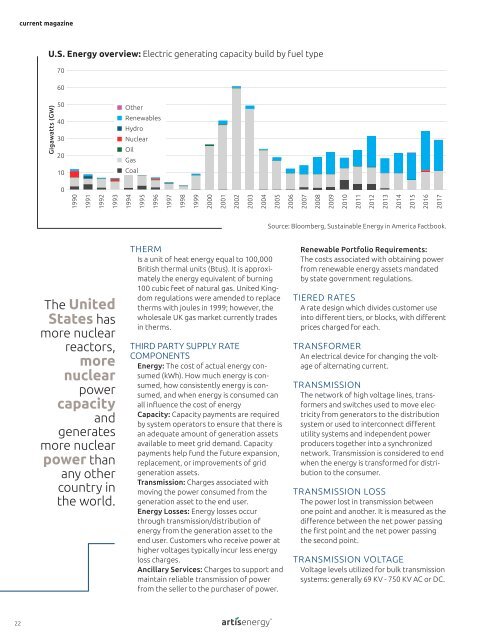Artis Energy Intelligence - Magazine Summer 2019
Create successful ePaper yourself
Turn your PDF publications into a flip-book with our unique Google optimized e-Paper software.
current magazine<br />
U.S. <strong>Energy</strong> overview: Electric generating capacity build by fuel type<br />
70<br />
60<br />
Gigawatts (GW)<br />
50<br />
40<br />
30<br />
20<br />
10<br />
n Other<br />
n Renewables<br />
n Hydro<br />
n Nuclear<br />
n Oil<br />
n Gas<br />
n Coal<br />
0<br />
1990<br />
1991<br />
1992<br />
1993<br />
1994<br />
1995<br />
1996<br />
1997<br />
1998<br />
1999<br />
2000<br />
2001<br />
2002<br />
2003<br />
2004<br />
2005<br />
2006<br />
2007<br />
2008<br />
2009<br />
2010<br />
2011<br />
2012<br />
2013<br />
2014<br />
2015<br />
2016<br />
2017<br />
Source: Bloomberg, Sustainable <strong>Energy</strong> in America Factbook.<br />
The United<br />
States has<br />
more nuclear<br />
reactors,<br />
more<br />
nuclear<br />
power<br />
capacity<br />
and<br />
generates<br />
more nuclear<br />
power than<br />
any other<br />
country in<br />
the world.<br />
THERM<br />
Is a unit of heat energy equal to 100,000<br />
British thermal units (Btus). It is approximately<br />
the energy equivalent of burning<br />
100 cubic feet of natural gas. United Kingdom<br />
regulations were amended to replace<br />
therms with joules in 1999; however, the<br />
wholesale UK gas market currently trades<br />
in therms.<br />
THIRD PARTY SUPPLY RATE<br />
COMPONENTS<br />
<strong>Energy</strong>: The cost of actual energy consumed<br />
(kWh). How much energy is consumed,<br />
how consistently energy is consumed,<br />
and when energy is consumed can<br />
all influence the cost of energy<br />
Capacity: Capacity payments are required<br />
by system operators to ensure that there is<br />
an adequate amount of generation assets<br />
available to meet grid demand. Capacity<br />
payments help fund the future expansion,<br />
replacement, or improvements of grid<br />
generation assets.<br />
Transmission: Charges associated with<br />
moving the power consumed from the<br />
generation asset to the end user.<br />
<strong>Energy</strong> Losses: <strong>Energy</strong> losses occur<br />
through transmission/distribution of<br />
energy from the generation asset to the<br />
end user. Customers who receive power at<br />
higher voltages typically incur less energy<br />
loss charges.<br />
Ancillary Services: Charges to support and<br />
maintain reliable transmission of power<br />
from the seller to the purchaser of power.<br />
Renewable Portfolio Requirements:<br />
The costs associated with obtaining power<br />
from renewable energy assets mandated<br />
by state government regulations.<br />
TIERED RATES<br />
A rate design which divides customer use<br />
into different tiers, or blocks, with different<br />
prices charged for each.<br />
TRANSFORMER<br />
An electrical device for changing the voltage<br />
of alternating current.<br />
TRANSMISSION<br />
The network of high voltage lines, transformers<br />
and switches used to move electricity<br />
from generators to the distribution<br />
system or used to interconnect different<br />
utility systems and independent power<br />
producers together into a synchronized<br />
network. Transmission is considered to end<br />
when the energy is transformed for distribution<br />
to the consumer.<br />
TRANSMISSION LOSS<br />
The power lost in transmission between<br />
one point and another. It is measured as the<br />
difference between the net power passing<br />
the first point and the net power passing<br />
the second point.<br />
TRANSMISSION VOLTAGE<br />
Voltage levels utilized for bulk transmission<br />
systems: generally 69 KV - 750 KV AC or DC.<br />
22


